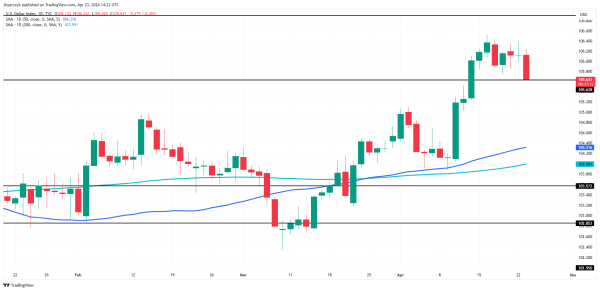US Dollar (DXY) Index News: Greenback Tumbles Following Bearish PMI Data
U.S. Dollar and Economic Indicators
The U.S. Dollar Index (DXY) declined on Tuesday following reports that U.S. business activity slowed and inflation metrics were mixed in April. The Federal Reserve is closely monitoring these developments to determine the need for further policy adjustments to manage ongoing inflation.
At 14:18 GMT, the U.S. Dollar Index is trading 105.678, down 0.442 or -0.42%.
US PMI Data Disappoints
The latest economic report indicates a notable slowdown in U.S. business activity, with the S&P Global’s flash U.S. Composite PMI Output Index falling to 50.9 in April from 52.1 in March, signaling the weakest expansion in four months. This slowdown was observed across both the manufacturing and services sectors, suggesting a broad-based easing in economic momentum.
Additionally, the labor market exhibited its first contraction since June 2020, particularly in the services sector, which could signal cooling employment trends. Despite these indicators, inflation rates slightly eased, although input prices remained high.
This mixed picture of cooling activity but persistent price pressures presents a complex challenge for policymakers aiming to steer the economy towards a stable growth trajectory without exacerbating inflationary trends.
Federal Reserve’s Policy Outlook
Despite signs of economic cooling, such as the dip in the S&P Global’s flash U.S. Composite PMI Output Index to 50.9 from 52.1, and a contraction in the labor market, the Federal Reserve suggests it will maintain the interest rate within the current 5.25%-5.50% range. This stance reflects a departure from previous hints at potential rate cuts, driven by persistent inflation and strong employment figures.
Market Reactions and Currency Market Impact
Traders have significantly revised their expectations, now seeing a lower probability of a rate cut starting in September. These expectations could be influenced by forthcoming economic data, including Q1 GDP and the PCE index, which will play a critical role in determining the Fed’s policy direction.
Short-Term Forecast
In the short term, the U.S. Dollar is expected to show strength. Anticipated economic reports are likely to highlight the resilience of the U.S. economy compared to its global counterparts, supporting a bullish outlook for the dollar. Despite some market speculation about potential Fed rate cuts later in the year, the immediate data suggests a strong dollar, backed by a restrictive Federal Reserve stance. This outlook suggests a bullish scenario for the U.S. Dollar in the near term, particularly against major currencies like the Euro and Yen, where central banks are grappling with more acute inflationary or economic pressures.
Technical Analysis

The US Dollar Index is under pressure on Tuesday after changing the short-term trend to down. The daily chart indicates there is plenty of room to the downside with the main targets the 50-day moving average at 104.316 and the 200-day moving average at 103.991.
The short-term uptrend will resume on a sustained move over 106.517.